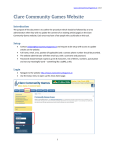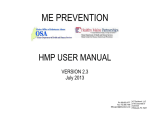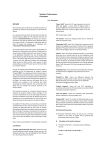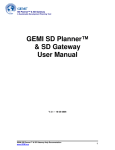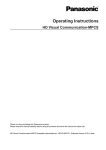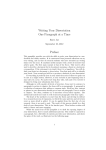Download HSE Management Standards Indicator Tool user manual
Transcript
HSE Management Standards Indicator Tool User manual Background HSE’s Management Standards Indicator Tool is a 35-item questionnaire relating to the six primary stressors identified in the Management Standards approach to tackling Work Related Stress. The questions are based on the best available evidence linking work design to health outcomes. It has been designed to support the process described in the Management Standards by providing a broad indication to organisations of how well their workforce rate their performance in managing the risks associated with work related stress. This User Manual provides guidance for using the HSE Management Standards Indicator Tool in a survey to gather the opinion of the workforce. The HSE Management Standards Indicator Tool can be used as a standalone questionnaire, or alternatively, the questions can be included in another question set, such as a pre-existing staff survey. It is recommended that the HSE Management Standards Analysis Tool be used to score the responses, regardless of whether it is used as a standalone measuring device or incorporated into a wider staff survey. The results from the HSE Management Standards Indicator Tool should be confirmed by discussing the findings with employees, and whether they are supported by other data available within the organisation, such as sickness absence rates, employee turnover etc. The User Manual covers: Getting a good response rate Analysing the results Selecting a sample The appendices provide: An example covering message for a staff survey; and A checklist for using the HSE Management Standards Indicator Tool. Getting a good response rate Obtaining a high response rate is important to ensure your results correctly reflect the situation in your organisation. As a crude rule of thumb, for a survey of this type, a response rate of over 50% could be considered adequate; over 60% desirable, over 70% good and more than 80% very good. With a response rate of less than 50%, the data should be considered as indicative only, and treated with extreme caution Another important factor in determining the reliability of your results is that the overall response rate is balanced across different types of worker and various locations; for instance much higher response rates are generally found in surveys of office-based staff than in surveys of manual workers. In line with this, some additional effort may be required to encourage non-office based staff to participate in the survey. This may sometimes be explained by the manner in which the survey is circulated or publicised, particularly where the questionnaire is computer based. You should ensure that those who do no have access to computers receive copies and are actively encouraged to complete and return their survey forms. If you are selecting a representative sample of workers, you will need to be sure that you have an up to date list of workers in your organisation. The list may be the payroll list, staff records, site security records or similar source. It is important that the list of workers you use is up to date and accurate to ensure all those in your sample receive their questionnaire and to ensure that they represent a proper sample group of the workforce. (See the section on selecting a sample for more information) There are several things you can do to encourage a good response rate in your sample before you start your survey. Not least is that employees should feel the questionnaire is important, that their views matter and that they will be acted on. Good ways to encourage this: Publicise the survey within your organisation; include supportive comments from senior management and employee/Union representatives encouraging people to take part, before it is distributed. Explain to all staff: The purpose of the survey; Why they should take part – what’s in it for them? How and when staff will be receiving a questionnaire; How and when staff will get feedback on results; and How actions will be taken to address survey findings. Ensure anonymity of responses. This will encourage employees to give frank and honest responses. A formal statement of anonymity at the beginning of the survey is the best way to do this. If you send out questionnaires by email give instructions to print them out and identify where to send completed hard copies. If you are adding questions about demographics e.g. asking which site or department they work in, or about grade, age groups, gender etc ensure that these are not sufficient to allow individuals to be identified. Use up-to-date and accurate records to distribute questionnaires to ensure they do not go to the wrong locations. Make sure everyone who needs access to a copy has access to one eg if you have staff that don’t regularly access a computer, send them hard copies or advertise where they can get one e.g. leave a supply in rest areas or arrange for all managers to meet with their staff to hand them out. Give people enough time to complete and return questionnaires, don’t set a closing date for the survey that is unrealistic and consider timing eg avoid major holiday times such as when the schools are closed over summer when more people may be taking leave. Ensure managers understand that the process is important and that they encourage their staff to take time to complete questionnaires. Allow staff surveys to be completed in work time rather than expecting them to complete it in their own time. We know that this provides much better response rates. Continue to publicise the survey throughout the process. Have one or two reminder activities before the closing date. Indicate on the material accompanying the questionnaire when and how the results will be communicated to all staff – and honour this commitment. Provide appropriate instructions on completion and a contact for support for completion if required. Consider the best medium for distributing, and returning the survey for your staff (e.g. paper based, staff intranet). If possible, it may be useful to offer different formats so individuals can select the most convenient for them, while maintaining their anonymity. If possible, provide some sort of incentive for completing the survey. One strategy that has proven effective in getting good and very good response rates in large, diverse workforce, is a small donation to a named charity for every survey that is completed and returned. An example covering message that can accompany the questionnaire is provided in Appendix A. Analysing Your Results HSE has developed the HSE Management Standards Analysis Tool to interpret the data generated from the HSE Management Standards Indicator Tool. The scores provided by the HSE Management Standards Analysis Tool are based on employee responses to HSE’s HSE Management Standards Indicator Tool. It provides summary information of how you are performing against each of the Management Standards stressors. The scores range from 1 (poor) to 5 (desirable). The information is presented in the form of bar charts providing, your organisation’s score on each of the six Management Standards areas. The tool is designed to accept data from up to three surveys, the current one and two previous sets of data. This allows an organisation to assess how its performance has changed over the period, identifying where improvement has occurred, which measures have provided the best By including demographic questions in the survey, you can make greater use of your data. For example, if you have two sites you can compare scores and identify good practice that could be adopted. If you have several teams carrying out different functions you can identify whether just on of these functions is problematic allowing you to better target solutions. With the information you have gathered you can compare your performance: Against previous survey(s) you have undertaken, with the aim of measuring progress; Across different parts of your organisation, with a view to identifying good parts that may have practices that would be beneficial for other parts to adopt; and Across areas/functions to identify distinct areas that may need some further localised action, identifying training needs in certain managers or satisfying yourself that the organisation does not have a problem. It is important to appreciate that the results of the survey alone can only provide an indication of performance in managing work-related stress, and you will need to share and discuss the outcomes of the survey with employees, and explore any issues raised in more detail, for example using focus groups. The intention is that all the data you collect can be used to promote a system of continuous improvement. Absence data and staff turnover are two other important indications of the prevalence of work-related stress in your organisation. You may also want to check records of disciplinary action or accidents since the affects of work related stress may increase aggression and lack of concentration Also, you should consider the states-to-be-achieved for each of the six Management Standards; these provide aspirational targets for what should be happening in your organisation, if it is to effectively manage work related stress. Selecting a Sample Ideally, the whole population of an organisation should have a say in a staff survey. Where this cannot happen, it is possible to get an indication of the situation if the sample is representative of the whole. There are two critical issues to consider in selecting a survey population that is representative: 1. How many workers do you need to sample; and 2. The method of selecting the sample of workers Recommended minimum sample size A survey including all your workers will always provide a more precise picture than a sample. The advantages of using a larger sample size include the possibility of more detailed sub-group analysis (e.g. using demographic questions such as occupational group) and give more of your staff the opportunity to give their opinions. The advantages of conducting a survey among the smallest recommended sample size is that it keeps costs to a minimum, and also reduces the staff time that is required. The minimum sample sizes have been calculated to ensure that the survey findings will give a statistically representative picture of the views of all staff in your organisation. Recommended minimum sample sizes are given in the table below. Total number of workers 500 or fewer 501-1000 1001-2000 2001-3000 Over 3000 1 2 Recommended minimum sample size1 to provide data accurate to at least 5%±2 All Workers 500 650 700 800 Assumes a response rate of 50% Relates to ±percentage of the resultant score If you are selecting a sample of workers, it is important that these are selected at random from your list of all workers. Random sampling provides a statistically valid way to gather data. It allows you to take results from the sample and use them as a best estimate of what represents the views of the whole workforce. Appendix A: Example of the content of a covering message to be sent to employees with the questionnaire [If you are sending out hard copies and it is possible, you should send a covering letter to named individuals on headed paper. The quality and professionalism of the covering message has been shown to have an effect on response rates.] Dear [Colleague or employee’s name], [Name of company] is committed to protecting the health, safety and welfare of its employees and we have been working with union/your representatives to try to identify where there may be risks to you. We recognise that work related stress is a health and safety issue and acknowledge the importance of tackling the causes of stress in our workplace. The attached questionnaire consists of 35 simple one-line questions, and some basic items about your work. The survey is designed to find out how you feel about various aspects of working conditions here. We are asking you and your colleagues to do this to be sure that we are doing all we can to make this a good place to work. The questions asked do not allow for any individual to be identified. Please read the instructions carefully, and complete your questionnaire as soon as you can. When the returned questionnaires have been analysed, the results will be shared with you. The next stage will be to organise discussions to confirm the results, decide what the key issues are, and reach agreement on appropriate action. Please take the time to complete the questionnaire. It will provide an indication of how well we are performing and it will give an indication of where any problem areas might be. Don’t rely on others to raise issues, stress is a subjective problem and can affect people in different ways. Your responses to this questionnaire will remain anonymous and only group data will be presented. It will not be used as an evaluation of your work or capabilities. The questionnaire takes about 15 minutes to complete. For each question tick the box that most accurately reflects your job as it is now. Please only tick ONE box for each question. When you have completed the questionnaire, please return it to [enter name of person or department]. This should be by [enter return date]. If you have any questions concerning completion of the survey please contact [enter contact name/phone number]. Thank you for participating. Yours sincerely, [This should be signed by someone senior and someone known to the employees] Appendix B CHECKLIST FOR USING THE HSE MANAGEMENT STANDARDS INDICATOR TOOL The following checklist suggests the steps you will need to complete, and the order in which you will need to complete them, if you are using HSE’s Management Standards Indicator Tool. Step 1: Distribute the HSE Management Standards Indicator Tool (survey questionnaire) to your employees and include instruction about where to return the questionnaire to and by what date. Appendix A contains an example of a covering message that you can adapt to send with the Indicator Tool. Step 2: Collate your data: Enter the data from the completed returned questionnaires into HSE’s Management Standards Analysis Tool. Step 3: HSE Management Standards Analysis Tool output: this will tell you how your organisation is performing for each of the sources of stress (e.g. Demands, Control, Support etc.). If you have carried out previous surveys you can enter that data to provide details of the changes in scores and see how the views of your staff have changed Step 4: Take further action: inform staff, employee representatives and other stakeholders of the results from the Indicator Tool. At this point you will also need to be planning the arrangements for discussing the findings with staff, for example, by running focus groups. Take the opportunity to compare the results with other available data eg sickness absence records, staff turnover figures, accident reports etc Step 5: Consult with your staff: HSE recommends that you hold some focus groups/staff forums to confirm the results of the Indicator Tool and explore further any topics that were highlighted as needing further action. Step 6: Summarise the discussions from Step 5: highlighting those issues that were of concern to the majority and the actions identified to help reduce them. Issues of concern to small groups and individuals should also be noted and addressed separately (refer to the HSE Stress website for guidance). Step 7: Feedback: inform staff of the main outcomes of the staff consultation, detailing action plans you have drawn up to improve stress management in your workplace. Step 8: Review: Conduct the process again after a suitable period of time to assess whether there have been changes / improvements. If changes are made to a localised group you can monitor the sickness absence records and other data from that area to see whether the steps taken are working.







